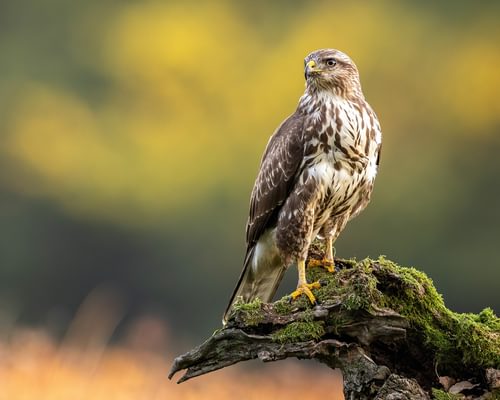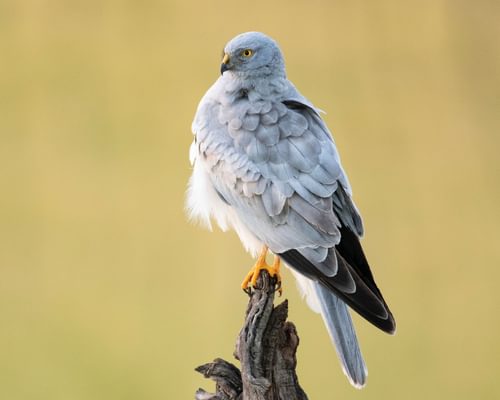Western Marsh-harrier
Circus aeruginosus
Visual Identification
Appearance
The Western Marsh-harrier is a large raptor with long, broad wings and a long tail. Males have a distinctive tricoloured plumage: grey head and wings, reddish-brown body, and black wingtips. Their eyes and legs are yellow.
Females are predominantly dark brown with a cream-coloured crown, throat, and leading edge of the wings. They're also about five percent larger than males on average. Juveniles resemble females but are darker overall with less contrasting head markings.
Size
Length
48cm to 56cm
Wingspan
115cm to 130cm
Weight
500g to 1.1kg
Habitat and Distribution
Habitats
Woodland
Garden
Wetland
Coastal
Urban
Farmland
Grassland
Desert
Tundra
Rainforest
Mountain
Savanna
Distribution
Western Marsh-harriers inhabit wetlands, including marshes, reedbeds, and wet grasslands across Europe, Asia, and parts of Africa. They prefer lowland areas with dense vegetation near water bodies.
In the UK, they are found primarily in eastern and southern England, with some populations in Wales and Scotland. During winter, many European birds migrate to Africa, while others move to coastal areas.
RSPB Minsmere in Suffolk is an excellent place to look for Marsh Harriers, although visiting other reedbed habitats in East Anglia may be rewarding. Somerset in the Southwest is also a good part of the country to look for Marsh Harriers.
Elevation Range
Up to 3,000 meters
Climate zones
Temperate, Subtropical
Distribution Map
This map gives you a rough idea of where you might spot a Western Marsh-harrier. The coloured areas show countries where these birds have been seen.
A few things to keep in mind:
- Birds might not be everywhere in the coloured areas, for example, they may be present around the coast of that country
- Where birds live can change with seasons and available food
- This map is quite simple - it doesn't show exact locations
We're working on making our maps even better! Soon, we hope to show you:
- More detailed maps for bigger countries, including state and region
- How birds move around during different seasons
Distribution by Region
Behaviour and Ecology
Bird Attributes
This feature is in beta. We'd love your feedback to improve it!
Share your thoughtsBird Attributes Explained
Our bird attributes system rates various aspects of a bird's capabilities on a scale of 0-100, based on data from field observations, scientific studies, and expert knowledge.
Attribute Categories:
- Agility: Manoeuvrability, speed, and grace in flight or movement.
- Strength: Physical power, often correlating with size and hunting abilities.
- Adaptability: Ability to thrive in various environments or changing conditions.
- Aggressiveness: Territorial behaviour and assertiveness, particularly during breeding seasons.
- Endurance: Stamina, often seen in migration patterns or foraging behaviours.
Understanding the Ratings:
- 0-20: Very Low
- 21-40: Low
- 41-60: Average
- 61-80: High
- 81-100: Very High
Remember, these attributes are relative to other bird species and don't necessarily indicate superiority.
Hover over the icon next to each attribute for more information.
Tap the icon next to each attribute for more information.
Agility
Reflects the bird's manoeuvrability, speed, and grace in flight or movement.
The Western Marsh-harrier displays remarkable agility in flight, with its ability to perform low, quartering flights over wetlands and sudden drops onto prey. Its spectacular aerial displays during courtship, including steep climbs and dives, further demonstrate its high level of agility.
Strength
Indicates the bird's physical power, often correlating with size and hunting abilities.
As a large raptor capable of taking a variety of prey, including small mammals and birds, the Western Marsh-harrier possesses considerable strength. Its ability to carry prey and construct nests with branches indicates good strength, though it's not among the strongest of raptors.
Adaptability
Represents the bird's ability to thrive in various environments or changing conditions.
The Western Marsh-harrier shows high adaptability, thriving in various wetland habitats across Europe, Asia, and parts of Africa. Its opportunistic hunting behaviour, diverse diet, and ability to hunt cooperatively demonstrate its adaptable nature. The species' comeback in the UK also suggests good adaptability to changing environments.
Aggressiveness
Measures the bird's territorial behaviour and assertiveness, particularly during breeding seasons.
While not overly aggressive towards humans, Western Marsh-harriers display moderate aggression in their hunting behaviour and during breeding season. Their ability to take a wide range of prey and their territorial behaviour during nesting suggest a moderate level of aggression.
Endurance
Reflects the bird's stamina, often seen in migration patterns or foraging behaviours.
The Western Marsh-harrier's endurance is evidenced by its ability to perform long, low flights while hunting and its migratory behaviour. Many individuals undertake long-distance migrations from Europe to Africa, indicating good endurance. However, they are not known for extremely prolonged flights compared to some other migratory species.
Diet
Western Marsh-harriers are opportunistic hunters, preying on small mammals, birds, reptiles, amphibians, and large insects. Birds up to the size of gulls and ducks are their most frequent prey. They also feed on carrion when available.
They often hunt by flying low over reedbeds and suddenly dropping onto their prey, sometimes wading into shallow water to catch fish.
Behaviour
Western Marsh-harriers are known for their low, slow flight over reedbeds and marshes, often tilting from side to side as they search for prey.
They are generally solitary but may gather in small groups during migration or at communal roosts.
Vocalisation
Western Marsh-harriers are generally quiet outside the breeding season. During breeding, they produce a series of sharp, nasal 'kek-kek-kek' calls. Males may also emit a high-pitched whistle during courtship displays, sometimes described as a 'pee-oo' sound. They also produce a cackling alarm call when threatened.
Nesting & Breeding
Breeding season for Western Marsh-harriers typically begins in April. Males perform spectacular aerial displays to attract females, including steep climbs and dives.
Nests are built on the ground or in dense vegetation, usually in reedbeds or marshes. They are constructed of reeds, grass, and small branches. Females lay 3-8 pale blue eggs.
Incubation lasts about 31-38 days, primarily done by the female. Chicks fledge after 35-40 days but remain dependent on parents for several more weeks.
Conservation and Status
Global Conservation Status
While currently listed as Least Concern globally, Western Marsh-harriers face threats from habitat loss, drainage of wetlands, and persecution. Conservation efforts focus on protecting and restoring wetland habitats, particularly in their breeding areas.
Marsh Harriers went extinct in Britain in the 1800s, and the current population grew from just one pair at the start of the 1970s. Today, there may be as many as 600 pairs, and they are not considered endangered. However, The species remains on the UK's amber list of conservation concern.
Birdwatching Tips
- Look for their distinctive low, quartering flight over wetlands and reedbeds
- Listen for their 'kek-kek-kek' call during breeding season
- Observe them in early morning or late afternoon when they're most active
- In the UK, visit coastal marshes and wetland reserves for the best chances of spotting them
- They're similar to the Buzzard but have a much ganglier look and are typically seen flying low over marshlands with their wings held in a characteristic v-shape.
Additional Information
Quick Facts
Other names:
Eurasian Marsh-harrier, Marsh Harrier
Family:
AccipitridaeAverage Lifespan
6 years
Max Lifespan
20.1 years [4]
Predators
Adult Western Marsh-harriers have few natural predators, but eggs and chicks may fall prey to foxes, raccoon dogs, and other ground predators.
Did You Know?
- Western Marsh-harriers can hunt cooperatively, with one bird flushing prey for another to catch.
- They are one of the few raptors that practice polygyny, with males sometimes mating with multiple females.
- In the UK, they were once extinct as a breeding species but have made a remarkable comeback since the 1970s.
FAQs
Is a Marsh Harrier an eagle?
Technically speaking, Marsh Harriers are not eagles. However, both birds of prey belong to the same bird family.
Is a Marsh Harrier bigger than a Buzzard?
Marsh Harriers are similar in size but have longer wings and legs than Buzzards. The Harrier has a lighter build, although large females often outweigh smaller Buzzard males.
How many pairs of Marsh Harriers are there in the UK?
There are an estimated 400 to 700 breeding pairs of Marsh Harriers in the United Kingdom.
Similar Birds
References
- 1 2 3
website: BirdLife International. 2021. Circus aeruginosus. The IUCN Red List of Threatened Species 2021: e.T22695344A203357709.
View source - 4
website, 2010: Fransson et al., EURING list of longevity records for European birds
View source
Share Your Feedback
We value your opinion! Let us know what you think about this bird page.

